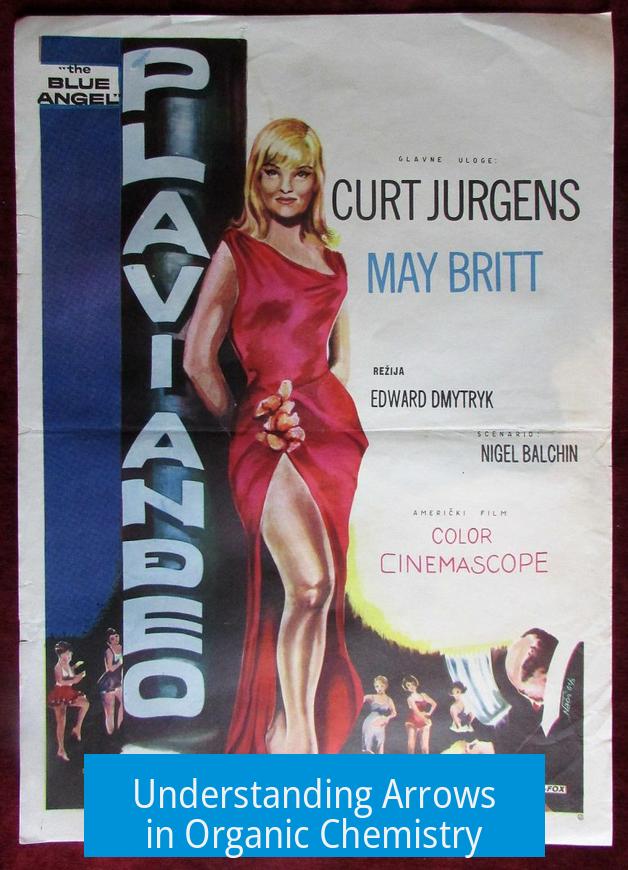Understanding Arrows in Organic Chemistry

Arrows in organic chemistry show where electrons move during reactions. They illustrate electron flow, which explains how bonds form or break. Arrows are central in understanding reaction mechanisms like nucleophilic substitutions and eliminations.
What Do Arrows Represent?
Arrows represent electrons traveling from one place to another. A double-headed arrow means two electrons are moving together. The base of the arrow indicates the starting point, usually a lone pair or a bond, and the tip points to where electrons move.
For example, in a C–Br bond, an arrow from this bond to Br means the bond electrons move to Br, making it negatively charged. The carbon loses those electrons and becomes positively charged.
Why Electron Movement Matters
Electrons must move for chemical transformations to happen. Atoms rearrange because electron pairs shift positions. Understanding these electron movements lets students predict reaction products and mechanisms.
Practical Tips for Mastering Arrow Pushing
Many students struggle initially. The best way to get better is by drawing all electron pairs on involved atoms clearly. Mark lone pairs and bonding electrons carefully.
- Draw lone pairs on nucleophiles, electrophiles, and leaving groups.
- Map the route electrons take, like a maze path.
- Electrons usually jump to adjacent atoms or orbitals, not across large distances.
- Visualize short, logical electron shifts instead of giant leaps.
One analogy is to think of electrons traveling stepwise, making short “jumps” to form or break bonds.
Arrow Pushing in SN2 Reactions: An Example
Electron Flow in the SN2 Reaction
In a typical SN2 reaction, electrons from a nucleophile attack an electrophilic carbon bonded to a leaving group, such as chlorine. Two electrons from the nucleophile’s lone pair move to form a bond with the carbon.
Simultaneously, two electrons in the carbon-chlorine bond break away to the chlorine, which becomes negatively charged. The nucleophile replaces chlorine in the molecule.
| Step | Electron Movement | Result |
|---|---|---|
| 1 | Lone pair on CN attacks carbon bound to Cl | New C–CN bond starts to form |
| 2 | C–Cl bond electrons move to Cl | Cl gains negative charge, bond breaks |
Mechanistic Explanation
The cyanide ion (CN−) donates electrons from its lone pair into an antibonding orbital (σ*) of the C–Cl bond. This weakens and breaks the C–Cl bond. The nucleophile bonds to the electrophilic carbon. This concerted movement causes the substitution.
Mechanistically, the sequence involves orbital overlaps that lead to bond transformation. Two electrons move from nucleophile to antibonding orbital, allowing another two electrons to shift to the leaving group. This is why the arrow starts at the lone pair and ends at the σ* orbital.
Orbital Perspective
Electron movement is an interaction between filled and empty orbitals. The nucleophile’s filled orbital (lone pair) interacts with the antibonding orbital on carbon-chlorine. As electrons move into the antibonding orbital, the bond breaks.
Following this, the nucleophile shares electrons with the carbon, creating a new bonding orbital. This orbital interaction is fundamental to arrow pushing and chemical bond formation/breaking.
Arrows and Molecular Orbital Theory
Arrows reflect interactions described by molecular orbital (MO) theory. When electrons move, they go from an orbital that contains electrons to an empty or partially filled orbital.
- Electrons flow from a filled atomic or molecular orbital (donor) to an empty orbital (acceptor).
- The interaction forms a lower energy bonding molecular orbital and a higher energy antibonding orbital.
- Electrons prefer the bonding orbital, stabilizing the molecule.
An example is the hydrogen molecule (H2), where two hydrogen atoms’ orbitals combine to form bonding and antibonding orbitals. The two electrons occupy the bonding orbital, stabilizing the bond.
If electrons enter an antibonding orbital, the bond can break, as seen in molecules with filled antibonding orbitals.
For example, helium atoms do not bond because their antibonding orbitals are filled, neutralizing bonding effects. This is relevant because arrows in mechanisms indicate electrons moving into or out of specific orbitals, which directly affects bonding.
Link to Molecular Orbital Diagram
A useful resource shows orbital overlap in hydrogen molecules: MO diagram for H2.
Improving Arrow Pushing Skills
Strong foundational knowledge helps mastery.
- Learn VSEPR theory well. Predicting molecular shapes helps visualize electron pairs.
- Practice drawing all electrons. Include lone pairs and bond electrons explicitly.
- Focus on charges. When electrons move, charges on atoms often change. Immediately mark these changes.
- Review orbital interactions. Understand donor-acceptor electron flow and antibonding orbitals.
- Practice stepwise reasoning. Move one arrow at a time and justify each move logically.
Patient, consistent practice is essential.
Summary of Key Points
- Arrows represent electron pair movement in chemical reactions.
- Double-headed arrows indicate two electrons moving.
- Arrows show electrons moving from a lone pair or bond to an atom or orbital.
- Electron movement explains charge changes and bond formation/breaking.
- SN2 reactions involve simultaneous nucleophilic attack and leaving group departure, indicated by arrows.
- Molecular orbital theory links arrow pushing to electron orbital interactions.
- Filling antibonding orbitals with electrons leads to bond breaking.
- Drawing all electron pairs, charges, and understanding orbital interactions aids arrow pushing skills.
What do the arrows in arrow pushing actually mean?
The arrows show where electrons move during a reaction. A double-headed arrow means two electrons move from one place to another.
How can I practice understanding arrow pushing better?
Draw all electron pairs on atoms involved. Visualize each electron move as a small step, not jumping across the entire molecule at once.
Why does the arrow start at a lone pair or bond and point somewhere else?
Because electrons are leaving one orbital (like a lone pair or bond) and entering an empty or antibonding orbital on another atom, forming or breaking bonds.
How does arrow pushing relate to bond making and breaking?
Electrons move into antibonding orbitals to break bonds. Electrons moving into bonding orbitals form new bonds between atoms.
What is the connection between arrow pushing and molecular orbitals?
Arrows represent electrons moving from an electron-filled orbital to an empty or antibonding orbital. This describes how bonds form or break at the orbital level.
Why do some bonds break when electrons fill antibonding orbitals?
Electrons in antibonding orbitals weaken a bond. When enough electrons occupy these orbitals, the bond breaks, as seen in molecules like helium dimers that don’t form stable bonds.





Leave a Comment